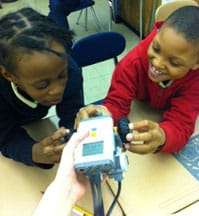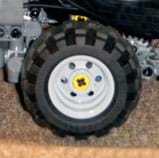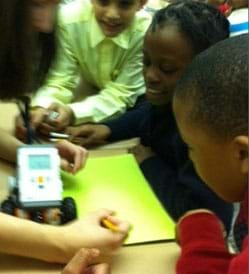Quick Look
Grade Level: 4 (3-5)
Time Required: 45 minutes
Expendable Cost/Group: US $0.00 The activity requires use of a non-expendable (reusable) LEGO MINDSTORMS robot; see the Materials List for details.
Group Size: 2
Activity Dependency: None
Subject Areas: Geometry, Measurement
NGSS Performance Expectations:

| 3-PS2-2 |

Summary
Students solidify their understanding of the terms "circumference" and "rotation" through the use of LEGO® MINDSTORMS® robotics components. They measure the circumference of robot wheels to determine how far the robot can travel during one rotation of a motor. They sharpen their metric system measurement skills by precisely recording the length of a wheel's circumference in centimeters, as well as fractions of centimeters. Through this activity, students practice brainstorming ways to solve a problem when presented with a given scenario, improve their ability to measure and record lengths to different degrees of precision, and become familiar with common geometric terms (such as perimeter and rotation).Engineering Connection
Engineers must have strong problem solving, measurement and spatial description (geometry) skills in order to be successful in their specialized fields. Accurate and precise measurements and descriptions are important to the design of all types of engineered products and projects.
Learning Objectives
After this activity, students should be able to:
- Determine the circumference of round and circular objects.
- Use a ruler to measure objects to the nearest fraction of a centimeter.
- Describe the concept of rotation.
Educational Standards
Each TeachEngineering lesson or activity is correlated to one or more K-12 science,
technology, engineering or math (STEM) educational standards.
All 100,000+ K-12 STEM standards covered in TeachEngineering are collected, maintained and packaged by the Achievement Standards Network (ASN),
a project of D2L (www.achievementstandards.org).
In the ASN, standards are hierarchically structured: first by source; e.g., by state; within source by type; e.g., science or mathematics;
within type by subtype, then by grade, etc.
Each TeachEngineering lesson or activity is correlated to one or more K-12 science, technology, engineering or math (STEM) educational standards.
All 100,000+ K-12 STEM standards covered in TeachEngineering are collected, maintained and packaged by the Achievement Standards Network (ASN), a project of D2L (www.achievementstandards.org).
In the ASN, standards are hierarchically structured: first by source; e.g., by state; within source by type; e.g., science or mathematics; within type by subtype, then by grade, etc.
NGSS: Next Generation Science Standards - Science
| NGSS Performance Expectation | ||
|---|---|---|
|
3-PS2-2. Make observations and/or measurements of an object's motion to provide evidence that a pattern can be used to predict future motion. (Grade 3) Do you agree with this alignment? |
||
| Click to view other curriculum aligned to this Performance Expectation | ||
| This activity focuses on the following Three Dimensional Learning aspects of NGSS: | ||
| Science & Engineering Practices | Disciplinary Core Ideas | Crosscutting Concepts |
| Make observations and/or measurements to produce data to serve as the basis for evidence for an explanation of a phenomenon or test a design solution. Alignment agreement: Science findings are based on recognizing patterns.Alignment agreement: | The patterns of an object's motion in various situations can be observed and measured; when that past motion exhibits a regular pattern, future motion can be predicted from it. (Boundary: Technical terms, such as magnitude, velocity, momentum, and vector quantity, are not introduced at this level, but the concept that some quantities need both size and direction to be described is developed.) Alignment agreement: | Patterns of change can be used to make predictions. Alignment agreement: |
Common Core State Standards - Math
-
Generate measurement data by measuring lengths using rulers marked with halves and fourths of an inch. Show the data by making a line plot, where the horizontal scale is marked off in appropriate units— whole numbers, halves, or quarters.
(Grade
3)
More Details
Do you agree with this alignment?
-
Multiply or divide to solve word problems involving multiplicative comparison, e.g., by using drawings and equations with a symbol for the unknown number to represent the problem, distinguishing multiplicative comparison from additive comparison.
(Grade
4)
More Details
Do you agree with this alignment?
-
Represent and interpret data.
(Grade
4)
More Details
Do you agree with this alignment?
International Technology and Engineering Educators Association - Technology
-
The process of experimentation, which is common in science, can also be used to solve technological problems.
(Grades
3 -
5)
More Details
Do you agree with this alignment?
State Standards
New York - Math
-
Generate measurement data by measuring lengths using rulers marked with halves and fourths of an inch. Show the data by making a line plot, where the horizontal scale is marked off in appropriate units— whole numbers, halves, or quarters.
(Grade
3)
More Details
Do you agree with this alignment?
-
Represent and interpret data.
(Grade
4)
More Details
Do you agree with this alignment?
-
Multiply or divide to solve word problems involving multiplicative comparison, e.g., by using drawings and equations with a symbol for the unknown number to represent the problem, distinguishing multiplicative comparison from additive comparison.
(Grade
4)
More Details
Do you agree with this alignment?
New York - Science
-
Make observations and/or measurements of an object's motion to provide evidence that a pattern can be used to predict future motion.
(Grade
3)
More Details
Do you agree with this alignment?
Materials List

Each group needs:
- ruler, for measuring in metric units
- LEGO MINDSTORMS robot wheel (of any size)
- piece of masking tape, ~25 cm long
- sheet of 8.5-in x 11-in (or A4) paper
- scissors
- 2 pencils
- Wheels Quiz, two per student
To share with the entire class:
- LEGO MINDSTORMS EV3 robot, such as EV3 Core Set (5003400) at https://education.lego.com/en-us/products/lego-mindstorms-education-ev3-core-set/5003400#lego-mindstorms-education-ev3 (instructions to build and program a basic robot are included with the robot kit; the kit is highly reusable) (Note: Using this LEGO system makes it easy to remove wheels and investigate them independent of the vehicle, and then re-install them for making circumference measurements.)
- chalk or whiteboard markers for the classroom board
Alternative: LEGO MINDSTORMS NXT Set:
Note: This activity can also be conducted with the older (and no longer sold) LEGO MINDSTORMS NXT set instead of EV3; see below for those supplies:
- LEGO MINDSTORMS NXT robot
Worksheets and Attachments
Visit [www.teachengineering.org/activities/view/nyu_robotwheels_activity1] to print or download.Pre-Req Knowledge
Students should have had some exposure to terms such as circumference and rotation.
Introduction/Motivation
(Administer and collect the pre-activity quiz, as described in the Assessment section.)
What do we mean when we say "rotation"? Who can give me a definition of "rotation"? (Listen to student suggestions. Then, illustrate the correct definition of rotation using your own body.)
Now watch and confirm that I have rotated once. (Rotate around once, a full time around.)
Watch again and tell me how far I rotate. (Rotate around halfway.)
Watch again and tell me how far I rotate. (Rotate around a quarter turn. Repeat, as necessary, until students understand the concept of body rotation.)
(Have ready a large wheel attached to an EV3 robot, with a clearly marked starting position on the wheel. Program the robot to rotate its wheel once around, returning it to its starting position.)
Now let's look at the concept of rotation as it applies to the wheels of this robot. (Have the robot move forward one rotation of its wheels. Repeat and question as before, to solidify this concept with respect to wheel rotation.)
What do we mean when we say "perimeter"? (Listen to student responses.) Where would we find the perimeter of the classroom? Of a football field? Of a drawn shape? (As necessary, clarify the difference between the distance around something at its outer edge, and its area.)
What do we mean when we say "circumference"? Who can give me a definition of "circumference"? (Listen to student suggestions. Then, illustrate the correct definition of circumference by drawing differently sized circles on the classroom board and having students use their own words to define the circumference of these shapes.) That's right; a circumference is the perimeter of a circle or a circular shape. It is a measure of length.
(Once students have demonstrated their understanding of these concepts, show them a LEGO EV3 robot wheel.) What is the circumference of this wheel? (Listen to student answers.) How could we figure it out?
Well, let's start by learning how we can make accurate measurements using a ruler. (Draw a large metric ruler on the classroom board, and review with students what the different distances and marks on the ruler mean. Start with whole centimeters, and progress until students can demonstrate proficiency with both measurement to the nearest centimeter, and to the nearest fraction of a centimeter.)
Procedure
Before the Activity
- Gather materials and make copies of the Wheels Quiz.
- Prepare the robot by having ready a large wheel attached to an EV3 robot, with a clearly marked starting position on the wheel. Program the robot to rotate its wheel once around, returning it to its starting position.
With the Students
- Administer the pre-activity quiz to the students. Collect the quizzes for later comparison to post-activity quiz scores.
- As presented in the Introduction/Motivation section, discuss with students the concepts of rotation, circumference, and measurement to the nearest centimeter and fraction of a centimeter.

Figure 1. Example blank table for students' predictions and data collection. - Direct the students to write on a piece of paper the following question and the blank table shown in Figure 1: How can one measure the circumference of a wheel? (Draw a blank table and write the question on the classroom board.)

Students measure the distance a wheel travels to determine its circumference. - Divide the class into groups of two students each. Instruct the groups to complete the following procedure.
- Part A: Prediction
- With your partner, estimate the circumference of the wheel you've been given.
- Record this estimate in the box marked "Prediction" in your table.
- Brainstorm ways to accurately measure the circumference of the wheel.
- Part B: Measurement 1
- Using the piece of masking tape, wrap it around the wheel's circumference one rotation.
- Mark on the tape the spot where one rotation occurs.
- Remove the masking tape from the wheel, and cut it at the one-rotation mark you made.
- Measure the length of this remaining tape to the nearest tenth of a centimeter.
- Record this measurement in the box in the table marked "Measurement 1."
- Part C: Measurement 2
- Place the wheel used for measurement, along with a matching wheel, on an EV3 robot.
- Place the robot on the sheet of paper.
- Use a pencil to mark on the paper the starting position of one wheel.
- Have the robot move forward one rotation of its motors.
- Use a pencil to mark on the paper the final position of the same wheel.
- Using a ruler, measure the length between the two marks to the nearest fraction of a centimeter.
- Record this length in the box in the table marked "Measurement 2."
- Instruct students to write a reflection about the three values of wheel circumference they have recorded in their tables, as described in the Assessment section.
- Conclude by administering the quiz again, as described in the Assessment section.
Vocabulary/Definitions
circumference: The length around a circle or closed curve.
perimeter: The length of the border or outer boundary of a drawn shape or area.
rotation: The movement of an object about itself.
Assessment
Pre-Activity Assessment
Pre-Activity Quiz: Before starting the activity, administer the Wheels Quiz to gauge students' base understanding of the subject matter.
Activity Embedded Assessment
Written Reflection: After completion of Parts A, B and C of the Procedure, ask students to write a brief written "reflection" about the three values of wheel circumference they recorded in their tables. Expect students to notice the similarity between the two non-predicted values, realize that the similarity in these values is a result of the definition of circumference, and come to the conclusion that these measured values should ideally be the same. The aim is for students to take away hands-on familiarity with the meaning of circumference, so that when they might otherwise stumble on the term in the future, they will have a solidly understood example in their memories to rely upon.
Post-Activity Assessment
Post-Activity Quiz: After completing the activity, administer the Wheels Quiz again. Compare students' answers to their pre-activity quizzes to determine their post-activity comprehension of the subject matter and skill enhancement.
Investigating Questions
- How can one determine the circumference of round and circular objects?
- How can one measure objects to the nearest fraction of a centimeter using a ruler?
- What does the word "rotation" mean, and why is this term important to wheel movement?
Activity Scaling
- For lower grades, emphasize the concept of rotation in place of circumference if the concept of circumference has not yet been introduced.
- For upper grades, add questions about how many rotations of a wheel with a known circumference it would take to move the robot a specified distance (multiplication and division problems).
Subscribe
Get the inside scoop on all things TeachEngineering such as new site features, curriculum updates, video releases, and more by signing up for our newsletter!More Curriculum Like This

Students develop and solidify their understanding of the concept of "perimeter" as they engage in a portion of the civil engineering task of land surveying. They measure and calculate the perimeter of a fenced in area of "farmland," and see that this length is equivalent to the minimum required leng...

Students are introduced to three of the six simple machines used by many engineers: lever, pulley, and wheel-and-axle. In general, engineers use the lever to magnify the force applied to an object, the pulley to lift heavy loads over a vertical path, and the wheel-and-axle to magnify the torque appl...
Copyright
© 2013 by Regents of the University of Colorado; original © 2011 Polytechnic Institute of New York UniversityContributors
Ursula KonigesSupporting Program
AMPS GK-12 Program, Polytechnic Institute of New York UniversityAcknowledgements
This activity was developed by the Applying Mechatronics to Promote Science (AMPS) Program funded by National Science Foundation GK-12 grant no. 0741714. However, these contents do not necessarily represent the policies of the NSF, and you should not assume endorsement by the federal government.
Last modified: October 16, 2020








User Comments & Tips